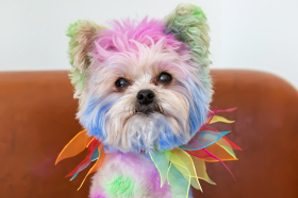Dyeing Dog - A Harmless Fun or Threat? | Dog Grooming

When actress Emily Watson stepped out with a bright pink Bichon Frise last year, it evoked strong reactions. Some were smitten, others horrified. 'Creative grooming' of dogs is shaping up to be the latest trend to land on our shores, but is it a degrading practice or simply harmless fun?
'It's just a bit of fun': Stuart Simons, Head practitioner at Groom Dog City, London
'I don't have a problem with dyeing dogs and I don't believe it has any detrimental effects. Apart from getting lots of extra attention, the dog isn't even aware it's a different colour - it's thought they only see in shades of grey.
'I'm often asked to groom dogs for fashion and TV. A bridal magazine wanted a Bichon Frise dyed pink for a shoot. I have a Bichon, so I did some research and dyed her. After the successful shoot, I dyed the dog Emily Watson was seen with, and the creative grooming really took off. I decided that, if customers want this, I need to know it's being done correctly. So I trained with the National Association of Professional Creative Groomers, based in the US, and I'm now one of only two qualified creative groomers in Europe.
'I take my responsibilities very seriously and I'm passionate about safety. The colours come from vegetable extracts, so they're not harmful, and the process doesn't take long - often only 10 minutes. Dye for humans or bleach should never be used, so this can only be done on light-haired dogs.
'Other new art forms include using chalks to create patterns - a doggie version of a temporary tattoo - or adding feathers to their hair.
'Creative grooming is not for every dog; I'd never do it on one that is nervous. Ultimately, it's just a bit of fun and should be seen as an extension of the pet's personality.'
'It's totally ludicrous': Denise Pope, Toy Poodle breeder and international show judge
'I think that dyeing dogs is totally ridiculous. Poodles - often picked for this - are beautiful just as they are. I can't see any positive side for the dog, who has no choice in the matter. I believe it's done for people who see their dogs as accessories. My dogs love attention, but at the end of the day they are free to run in the fields and just be dogs.
'Breeders strive for one goal: producing healthy, happy dogs that conform to the breed standard. 'Creative' grooming detracts from this.
'Trimming is fine: Poodles are water dogs and used to be clipped so that their dense coats didn't get waterlogged. Trimming pays homage to their heritage, while dyeing just makes them look ludicrous.
'I'd hate to see creative grooming take off here, like the other American trend for 'handbag' dogs. Dogs are dogs - they need to be socialised with their own kind, not carried around like a toy.
'I know that the dyes are natural, but I worry that the practice gives people the wrong expectations - that a dog is a plaything they can decorate. If people buy a dog for the wrong reasons, there's a danger that when they discover their dog is very intelligent and needs exercise, they will abandon him, increasing the rehoming numbers.
'Dogs are incredibly loyal and loving and deserve to be treated with respect, not made to look ridiculous.'
Debate adjudicated by Jo Leevers.
What do you think?
The trend of dyeing dogs is certainly controversial. Evidence for this was seen earlier this year on our Petplan UK Facebook page when we posted a picture of Kobe the poodle (otherwise known as the 'Sesame Street' dog) who won a dog grooming competition for his extreme styling. We asked readers' thoughts on this 'creative grooming' and nearly all responses were strongly against it, deeming it wrong and degrading. However, as Stuart Simons demonstrates above, not everyone disagrees with the practice.
What are your thoughts on creative grooming? Would you dye your dog?
We'd like to carry on the debate, so let us know what you think in the box below.

